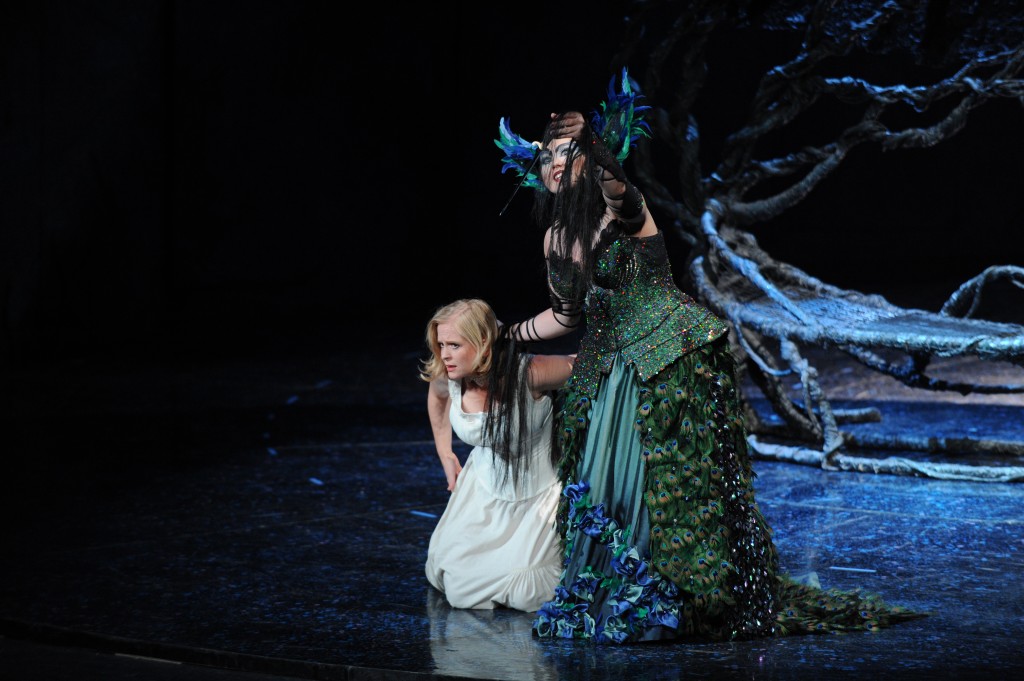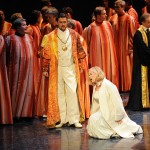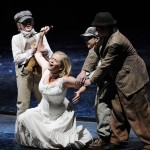
Handsomely staged, Vienna Volksoper’s production of Mozart’s Die Zauberflöte actually looks better than Vienna State Opera’s. Do the sets matter when Mozart’s opera is so familiar? Yes! if the opera is to make sense of the confusing and fantastical plot that can descend into pantomine. But Mozart’s last opera, composed concurrently with the Requiem – is both comic and serious. Sarastro’s religious order might be an allegory for a masonic order (to which Mozart allegedly belonged) ; but the opera rather represents good prevailing over the (evil) magic exercised by the ‘Queen of the Night.’ And Mozart/Schickaneder’s Die Zauberflöte celebrates the dawning of Enlightenment, and perhaps, premiered in 1791, even a new political order.
Vienna Volksoper’s Magic Flute (directed by Helmuth Lohner) is effectively set in the 19th Century. There’s none of the post-modern switching between ‘period’ and contemporary . Or the anarchic disorientation of, say, Peter Stein’s WNO 1990s production set on a Los Angeles beach. And, from the Overture , a high musical standard is ensured by the refined orchestral sound ( Volksoper Orchestra ably conducted by Alfred Eschwe), with quality woodwind playing: mellow, mature strings with real depth.
Even the opening ‘dragon’ scene, usually embarrassing, works – cast in twighlight gloom, with the scary monster serpent disappearing into a cavity centre stage. The Queen’s ‘Three Ladies’, who loom over the prostrate man, in Victorian ruffled gowns and bonnets, are perhaps too elegant . Tamino awoke (JunHo You) sings with a terrible German accent. Papageno, in a grey suit and hat – looks every bit the Victorian natural scientist, here birdwatcher. Klemens Sander is an excellent baritone. But is he a little too serious for this impish role?
The problem is the ‘eastern’ Tamino and the traditional I9th century naturalist -authentic Wienerwald– doesn’t make sense. Papageno, in the opera, is the social outsider, not Prince Tamino. The Three Ladies reappear in grungy taffeta gowns, gothic, spiked up hairdos- all black, rather vampiric. Papageno, beaten up, Tamino is enticed by a picture of Tamina (the Queen’s kidnapped daughter.) Tamina’s picture is projected onto the backstage- cleverly done. (We’re looking forward to seeing her.) Tamino’s Mein Herz aria shows JunHo You’s tenor impressive, but not distinctive.
The Queen of the Night (Beate Ritter) rises out of the centre-stage circular platform, in black with extended hairpiece. Such an exquisite light soprano, but the innocent quality is rather inappropriate. High pitched, fragile? Does she know what she’s singing, (a tale of sworn revenge?) Ritter, revealing a glittering turquoise skirt, achieves a superb, bird-like pitch, offering the magic flute and bells for Tamino and Papageno’s protection.
In the first Act , set as if in a cave, Pamina is first seen in a white gown, trapped (by Monostatus) like a butterfly in a net. Papageno brings Pamina the news that she’s to be freed. Their famous duet, filled with happiness, is about the power of love. As good-natured Papageno, complaining he needs a wife, Klemens Sander seems too mature, and authorative. Andrea Bogner’s soprano is only pleasant.
 But if the cast is ordinary, or mis-cast, Vienna Volksoper’s sets (Johan Engels) are spectacularly effective. The portal to the Temple, in gold , has inscribed in huge letters Weisheit, Natur, Vernunft (Wisdom, Nature, Reason)- virtually slogans for an Enlightenment manifesto. Sarastro (bass Andreas Daum) in a white waistcoat, donning a cloak with gold lining, is like the Professor of an academic establishment. Daum’s is a deep, tremendous bass- obviously a seasoned performer. Sarastro’s wiseman has moral authority, but Daum’s affable character is not physically fearsome.
But if the cast is ordinary, or mis-cast, Vienna Volksoper’s sets (Johan Engels) are spectacularly effective. The portal to the Temple, in gold , has inscribed in huge letters Weisheit, Natur, Vernunft (Wisdom, Nature, Reason)- virtually slogans for an Enlightenment manifesto. Sarastro (bass Andreas Daum) in a white waistcoat, donning a cloak with gold lining, is like the Professor of an academic establishment. Daum’s is a deep, tremendous bass- obviously a seasoned performer. Sarastro’s wiseman has moral authority, but Daum’s affable character is not physically fearsome.
Again well staged, Tamino’s on his knees, as the door to the Temple opens up, at first to reveal a petrified forest scene. An orange cluft, opening back of stage, represents Enlightenment, through which Sarastro and his priests emerge. In the Act 1 climax, Tamino’s led before the Assembly, the lovers meeting for the first time, Andrea Bogner’s Pamina’s lightweight floundering is simply not up to the part. Tamino sounds under-nourished. But the staging is beautiful: ranks of priest -like figures in orange striped gowns, centre-stage Sarastro, in white suit and magic cloak, like Prospero, the lovers to be ritually separated, on either side.
Also impressive is the inner temple opening Act 2, a circular chamber, with seated black-suited men with top hats and donning honorary stripes. In the centre, the throne is rather a pedestal housing a huge telescope. So an observatory , as if this were a scientific academy. Thus the staging anticipates 19th century industrial/scientific advances.
By contrast the Three Ladies in shimmering black dresses, with top hats and white bows -like hostesses in a sex club – look dangerous, (tempting Tamino and Papageno not to trust Sarastro.) And, in this polarisation of good and evil, night and day, Monostatos tries to kiss the sleeping Pamina. But disturbed by the Queen of the Night. She tells her daughter about the cosmic secret -the inner circles of the sun- Pamina’s father gave to Sarastro’s initiates. Now she wants to avenge herself, and offers Pamina a dagger to kill Sarastro.
The Queen appears, ascending through a circular stage, backed by a crescent moon, Beate Ritter in emerald turquoise with a horn -like headpiece. But Ritter’s soprano is too thin. She hits the right notes, like an exotic bird rather than a sorceress. She’s not really threatening, hers rather a voice to bewonder.(Pamina, nevertheless, is collapsed center stage in fear). And (Jeffrey Treganza’s) thin built, white-shirted, Monostatos – who tries to rape her- shouldn’t he be monstrous, if not physically?
Bogner’s Pamina is also disappointing in her key scenes. When she approaches Tamino -‘Are you sad?’- he’s sworn (as Papageno) not to speak. The audience laughed. (Bogner’s soprano struggled uncomfortably.) But Tamino’s silence, her imagined rejection, are grounds for Pamina’s attempted suicide. 
Later, Pamina enters in a white gown , brandishing a knife. She’s prevented by the three Knaben (Vienna Boys Choir): absolutely enchanting. Their singing was enough to stop her; even to inspire Bogner to sing better.
Again, outstanding set, two winged messengers like statues guarding the sacred portals, are the backdrop for the wonderful duet between Tamino and Pamina, sworn to each other’s love, led by the Zauberflöte. Superb flute accompaniment, but routinely sung.
In the comic sub-plot, Papagena , who in brown rags had the audience in stitches, sheds her disguise and emerges, pink- haired, in shocking rose-pink satin. And proceeds to a striptease down to her satin bloomers. Johanna Arrouas was deservedly well applauded.
So the sets rather upstage the performers . The staging, especially in the closing scenes, dramatically points up the underlying thematic. First, in a pink cloud, emerge the Queen, Ladies and conspirators- the huge dark sphere, crescent moon as backdrop. To a crack of thunder, they are dispersed , sinking into the abyss centre stage. The Enlightenment is represented by Sarastro and his followers, who enter from the back of a circular stage done out in gold, reflected through mirrors side stage. They, the priests(Volksoper Chorus) face us, the whole stage lit up like a radiant sun, with the cast lined up front of stage. Thus ‘Enlightenment’ reason prevails over dark, reactionary, mystical forces. PR. 22.06.2013 ö
Photos (c) Dimo Dimov/Volksoper Wien
Birgid Steinberger (Pamina), Jennifer O’loughlin (Queen of the Night); Karl Huml (Sarastro) ; Birgid Steinberger and Three Knaben from Vienna Boys Choir.
Unfortunately photos for the June 2013 performance cast were not available.
viennaoperareview.com
Vienna's English opera blog
